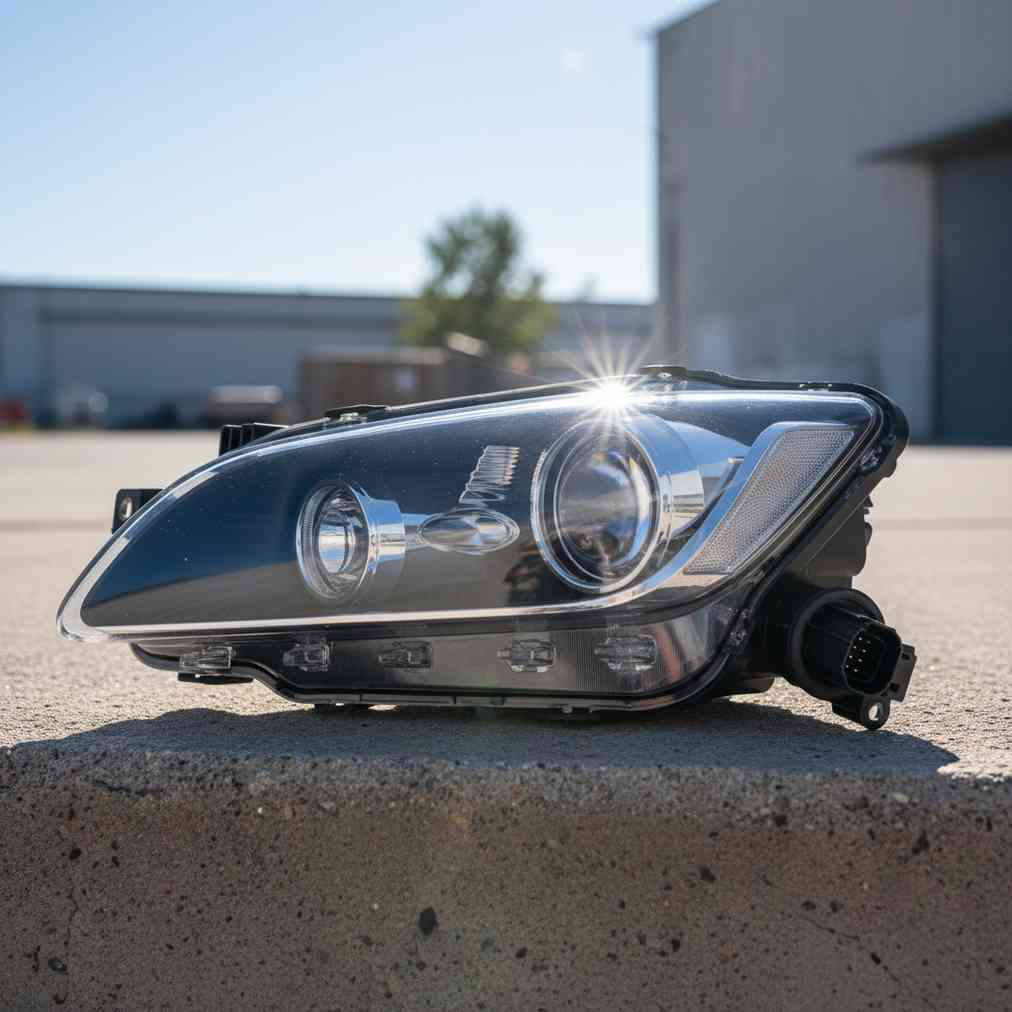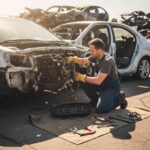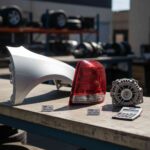Understanding the Basics of Finding Working Headlights and Taillights
Finding reliable, working headlights and taillights for common vehicle models doesn’t have to break the bank. With salvage yards offering OEM parts at fraction of dealership costs – sometimes saving you over $1,000 for a single assembly – smart sourcing strategies can keep your vehicle roadworthy without emptying your wallet. The key lies in knowing where to look, what to inspect, and how to leverage modern technology to make informed purchasing decisions.
Modern salvage yards and wrecking facilities have evolved beyond simple part storage. Many now utilize computerized networks connecting thousands of yards nationwide, making it easier than ever to locate specific lighting assemblies for your vehicle. When searching for junkyards near me, you’ll discover that these facilities often maintain extensive inventories of common models, ensuring higher success rates for finding compatible parts.
Leveraging AI and Image Recognition for Part Identification
The integration of generative AI and image recognition tools has revolutionized how we identify and verify automotive lighting parts. These sophisticated systems can analyze uploaded photographs against vast databases, providing instant feedback on compatibility, condition, and authenticity. Some advanced platforms can even identify car makers by taillight design within seconds, streamlining the identification process significantly.
When using AI-powered identification tools, photograph quality becomes crucial. The system’s accuracy depends heavily on clear, well-lit images that showcase key identifying features. These tools can detect up to 20,000 classes of spare parts and provide detailed specifications, part numbers, and compatibility information instantly.
Essential Photo-Taking Techniques for Maximum AI Accuracy
- Isolate the part – Ensure only a single lighting assembly appears in the frame
- Capture multiple angles – Include front, side, and rear views when possible
- Highlight key features – Focus on part numbers, manufacturer logos, and unique design elements
- Maintain sharp focus – Blurry images significantly reduce AI recognition accuracy
- Include contextual markings – Photograph any visible casting codes or stamped information
According to professional photography guidelines, proper preparation and lighting can dramatically improve identification success rates. Clean the part surface before photographing to remove dirt and grease that might obscure important details.
Physical Inspection Checklist for Used Lighting Assemblies
While used lighting assemblies are generally low-risk purchases due to their lack of moving parts, thorough physical inspection remains critical. The condition of lenses, reflectors, and mounting points directly impacts both functionality and longevity of your replacement parts.
| Inspection Area | What to Check | Red Flags |
|---|---|---|
| Lens Condition | Clarity, scratches, UV damage | Deep cracks, severe hazing, water intrusion |
| Reflector Surface | Coating integrity, rust-free surface | Peeling chrome, corrosion spots, dull finish |
| Mounting Tabs | Structural integrity, proper alignment | Cracks, breaks, stress fractures |
| Bulb Connectors | Corrosion-free contacts, proper fit | Green corrosion, melted plastic, loose connections |
Expert advice from experienced salvage professionals emphasizes the importance of bringing your original bulb or connector for direct comparison. This simple step can prevent costly compatibility issues and ensure proper fitment before purchase.
Understanding Lens Materials and Aging
Modern automotive lenses are typically manufactured from polycarbonate plastic, which offers excellent impact resistance but can suffer from UV degradation over time. Slight yellowing or cloudiness doesn’t necessarily disqualify a part, but severe hazing that reduces light transmission should be avoided. Professional restoration techniques can sometimes salvage moderately damaged lenses, making them viable options for budget-conscious repairs.
Strategic Sourcing Locations and Networking
Successful part sourcing requires understanding the salvage yard ecosystem and leveraging available resources effectively. Traditional walk-in yards offer hands-on inspection opportunities, while modern computerized facilities provide searchable inventories and condition reports. Many yards now participate in national networks, dramatically expanding your search radius for rare or specific parts.
“Photograph all damage—you may be tempted to avoid damaged parts of your vehicle, but it’s important to include pictures of any issues. The buyer will see the car at collection and will adjust their quote for any inaccuracies, which could be lower if they’re not aware of all impairments beforehand.”
— Scrap Car Comparison expert advice
When working with salvage yards, establishing good relationships with staff can provide access to newly arrived inventory and special-order capabilities. Many facilities will hold parts for regular customers and can even get specific parts from their network partners.
Online Resources and Digital Platforms
- Car-part.com – Nationwide salvage yard search by zip code
- Yard-specific websites – Real-time inventory and pricing
- Mobile apps – GPS-enabled yard locators with user reviews
- Social media groups – Model-specific communities sharing part locations
- Online marketplaces – Individual sellers and small yards
Digital inventory systems have made finding OEM car parts more efficient than ever. Many modern salvage facilities photograph every vehicle upon arrival and maintain searchable databases of available parts, complete with condition assessments and pricing information.
Cost Analysis and Value Optimization
Understanding the true cost of lighting assembly replacement helps justify the time investment in sourcing quality used parts. New headlight assemblies can range from $200 to $600 per pair for standard vehicles, while luxury or high-performance models with LED or laser technology can exceed $2,000 per assembly. These dramatic cost differences make used part sourcing an attractive option for most vehicle owners.
Factor in additional costs when planning your purchase. Halogen bulb replacement typically adds about $15 per bulb, while HID or LED bulbs can cost $50-150 each. Professional installation, if required, may add $50-150 to your total project cost, but many lighting assemblies are designed for straightforward DIY replacement.
Model-Specific Considerations for Common Vehicles
Different vehicle manufacturers employ varying design philosophies and mounting systems for their lighting assemblies. Understanding these differences helps streamline your search and ensures compatibility. Japanese manufacturers like Toyota and Honda typically use standardized mounting systems across model years, making cross-compatibility more likely. European manufacturers often integrate complex electronics and adaptive systems that require exact year-model matching.
American manufacturers fall somewhere between these approaches, with Ford F-150 and Chevrolet Silverado parts often sharing compatibility across multiple years within the same generation. When sourcing parts for these popular models, check generation boundaries carefully, as major redesigns typically reset compatibility windows.
High-Volume Model Advantages
- Greater availability – More donor vehicles in salvage yards
- Lower prices – Increased supply reduces individual part costs
- Better condition options – More units to choose from means better selection
- Established compatibility data – Well-documented fitment information
- Aftermarket alternatives – More reproduction options if OEM parts aren’t available
Advanced Verification Techniques
Beyond basic visual inspection, several advanced techniques can verify part authenticity and condition. VIN-based searching provides the most accurate compatibility confirmation, as it accounts for mid-year changes and option packages that might affect lighting system specifications. Many modern salvage yards can perform VIN lookups to confirm exact part matches.
Professional-grade collision repair photography techniques can document part condition for future reference or warranty purposes. Taking before-and-after installation photos creates a record that can be valuable if issues arise later.
Electronic System Verification
Modern vehicles increasingly integrate lighting systems with electronic control modules. Adaptive headlights, automatic leveling, and LED daytime running lights all require specific electronic interfaces that must match your vehicle’s systems exactly. When sourcing parts with electronic integration, verify that all necessary modules and wiring harnesses are included.
Some salvage yards now offer electronic system testing services, using diagnostic equipment to verify module functionality before sale. This service typically adds $25-50 to the part cost but can prevent costly compatibility issues with complex electronic systems.
Quality Assurance and Testing Procedures
Implementing systematic testing procedures ensures your sourced lighting assemblies meet safety and performance standards. Bench testing using a 12V power supply can verify bulb function and detect potential electrical issues before installation. This simple step can prevent the frustration of discovering problems after completing the installation process.
| Test Type | Equipment Needed | What It Verifies |
|---|---|---|
| Visual Inspection | Good lighting, magnification | Physical condition, damage assessment |
| Electrical Testing | 12V power supply, multimeter | Circuit continuity, bulb function |
| Fit Testing | Vehicle access, basic tools | Mounting compatibility, alignment |
| Light Output | Dark environment, measuring tape | Beam pattern, brightness levels |
Professional shops often use light meters and beam pattern analyzers to ensure replacement assemblies meet original specifications. While such equipment isn’t necessary for basic replacements, it can be valuable when working on vehicles with critical lighting requirements or when planning to sell a junk car that needs functional lighting for safety compliance.
Installation Best Practices and Common Pitfalls
Successful installation of sourced lighting assemblies requires attention to detail and proper preparation. Pre-installation cleaning of mounting surfaces and electrical connections ensures optimal performance and longevity. Use dielectric grease on electrical connections to prevent corrosion, and always verify ground connections before finalizing installation.
- Document original installation – Take photos before removal for reference
- Protect electrical connections – Use dielectric grease and proper sealing
- Verify alignment – Ensure proper beam aim after installation
- Test all functions – Check high beam, low beam, and turn signals
- Secure mounting hardware – Use appropriate torque specifications
Common installation mistakes include ignoring beam alignment and inadequate electrical connection protection. Misaligned headlights create safety hazards and may result in traffic citations, while poor electrical connections can cause premature failure and potential fire hazards.
Long-term Maintenance Considerations
Properly maintained used lighting assemblies can provide years of reliable service. Regular cleaning and inspection helps identify developing issues before they become serious problems. UV protection treatments can slow lens degradation, while periodic electrical connection cleaning prevents corrosion-related failures.
Consider keeping detailed maintenance records, especially if you’re involved in crash repair using junkyard parts. Documentation demonstrates proper care and can be valuable for insurance purposes or future resale considerations.
Emerging Technologies and Future Trends
The automotive lighting industry continues evolving rapidly, with LED technology becoming standard and adaptive lighting systems gaining popularity. These developments affect both sourcing strategies and long-term availability of traditional parts. Understanding these trends helps make informed decisions about repair versus replacement options.
Artificial intelligence and machine learning applications in part identification and condition assessment continue advancing. Some systems now provide predictive failure analysis based on part age, usage patterns, and environmental factors. These tools help prioritize replacement timing and budget planning for multiple vehicle maintenance.
Digital inventory management and augmented reality applications are beginning to appear in salvage yard environments. These technologies promise to further streamline the sourcing process by providing real-time part availability, condition assessment, and installation guidance directly to your mobile device.
Successfully sourcing working headlights and taillights for common models requires combining traditional inspection skills with modern technology tools. By leveraging AI identification systems, maintaining thorough documentation practices, and understanding the unique characteristics of your target vehicle, you can consistently find quality replacement parts while avoiding common pitfalls. The key lies in patience, systematic approach, and willingness to invest time in proper verification procedures that ensure long-term satisfaction with your sourced lighting assemblies.





Leave a Reply
You must be logged in to post a comment.